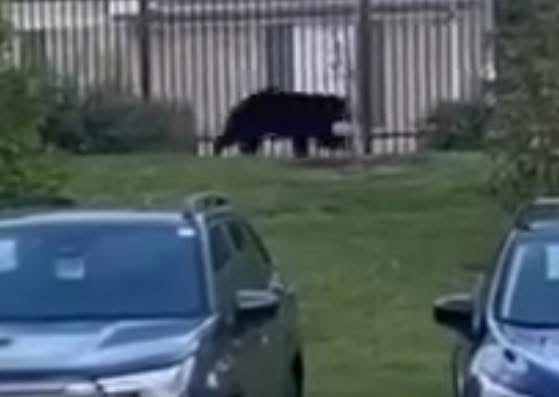SAD TO REPORT: Juvenile Black Bear Struck and Killed on Vietnam Veterans Parkway in Gallatin, TN
A tragic scene unfolded this morning along Vietnam Veterans Parkway (State Route 386) between exits 12 and 14 in Gallatin, Tennessee. Multiple drivers reported a disturbing sight—a juvenile black bear, previously spotted roaming the area in recent days, was struck and killed by a vehicle. The Tennessee Highway Patrol and other law enforcement agencies quickly arrived at the scene, where the bear’s body now lies along the shoulder of the roadway.
This unfortunate incident, confirmed by aerial footage from Sky5, has left many in the community heartbroken and frustrated. The young bear had become a well-known and widely watched figure in recent days, with social media posts and local news coverage documenting its rare appearance in the growing suburban sprawl northeast of Nashville. While sightings were initially met with awe and curiosity, they soon gave way to worry—especially as the bear was frequently spotted near high-traffic areas.
Community Fears Realized
Many residents had voiced concern about the bear’s safety, especially as it lingered in increasingly populated and dangerous zones. The very thing people feared most—an encounter between the bear and a speeding vehicle—has now come to pass.
“This was exactly what we were worried about,” said one local resident who had seen the bear just the day before near a gas station off the highway. “He was just a baby. You could tell he was confused and scared. It didn’t have to end this way.”
What Was Known About the Bear
The bear was a juvenile, likely recently weaned and dispersing in search of new territory—a natural behavior for young black bears in the spring and early summer. While black bears are common in East Tennessee and parts of Middle Tennessee, it’s still relatively rare for one to show up in suburban areas like Gallatin. However, as bear populations recover and natural habitats become more fragmented, sightings in unexpected places are becoming more frequent.
The Tennessee Wildlife Resources Agency (TWRA) had been made aware of the bear’s presence and was monitoring the situation, but, to the knowledge of the public, no active measures had been taken to relocate or tranquilize the animal.
Could This Have Been Prevented?
This morning’s tragedy has reignited questions about when and how wildlife officials decide to intervene in situations like this.
TWRA has specific protocols for tranquilizing and relocating bears. According to the agency’s own guidelines, a bear may be tranquilized and moved if it:
- Has attacked or stalked a human
- Is unafraid of people or approaches them repeatedly
- Has caused property damage
- Has entered a building, vehicle, or dwelling
- Has become habituated to non-natural food sources
- Refuses to leave an area even when humans are present
Many locals are pointing to the final point—the bear’s unwillingness or inability to leave a human-populated area—as grounds for a more proactive response from TWRA. Over the last several days, the bear had been seen near businesses, homes, and major roadways. Some feel that TWRA should have taken action to sedate and relocate the bear before it encountered danger.
“Even if he wasn’t aggressive, it was clear the bear was disoriented and trapped in a place that wasn’t safe,” said one local wildlife enthusiast. “It’s not just about protecting people—it’s about protecting the animal, too.”
The Broader Issue: Wildlife and Urban Sprawl
This incident has also renewed attention on the broader issue of wildlife displacement. As development continues across Tennessee, particularly in previously forested or rural areas, animals like bears, coyotes, and deer are increasingly forced to navigate human environments. This puts both animals and people at risk.
Wildlife biologists note that juvenile bears like this one are particularly vulnerable. With less experience and no established territory, they’re more likely to wander into populated areas. Without timely intervention, these situations can end in conflict or tragedy—as they did today.
What’s Next?
At this time, TWRA has not issued an official statement about the bear’s death or what, if any, efforts were considered to move the animal. Law enforcement remains on the scene, and the bear’s body is expected to be removed shortly.
Meanwhile, members of the public—and several local journalists—are calling for greater transparency and accountability in how wildlife cases like this are handled.
“I will be looking into this further,” one concerned local wrote on social media. “We need to understand what decisions were made, what options were considered, and how we can do better next time.”
In Memory of a Young Life Lost
Though it was only a bear—nameless, wild, and just passing through—many in Gallatin have expressed a deep sense of loss. Photos from the scene show a young animal that posed no harm to humans, only searching for safety in an unfamiliar world. Its tragic end is a reminder of the challenges wildlife face in our rapidly changing landscapes, and a call to better protect the creatures with whom we share this land.
As Tennessee continues to grow, incidents like these will likely increase. But the question remains: Can we learn from this moment and take steps to ensure that future wandering bears have a better chance at survival?
Time will tell. But for today, a stretch of highway near Gallatin stands as the silent witness to a young life gone too soon.
